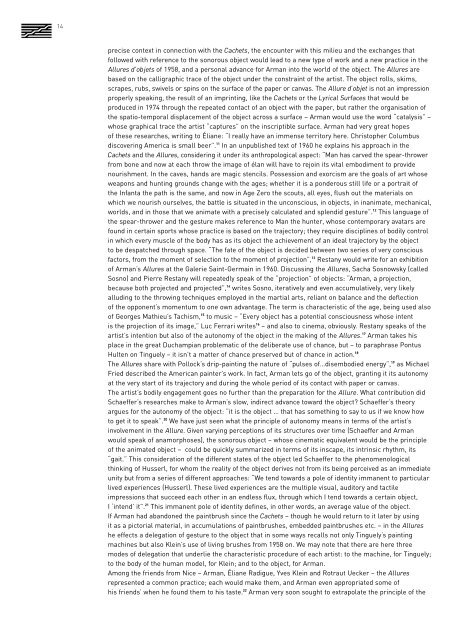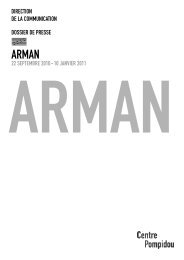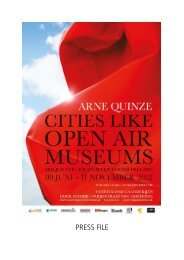Arman - Vicky David Gallery
Arman - Vicky David Gallery
Arman - Vicky David Gallery
You also want an ePaper? Increase the reach of your titles
YUMPU automatically turns print PDFs into web optimized ePapers that Google loves.
14<br />
precise context in connection with the Cachets, the encounter with this milieu and the exchanges that<br />
followed with reference to the sonorous object would lead to a new type of work and a new practice in the<br />
Allures d’objets of 1958, and a personal advance for <strong>Arman</strong> into the world of the object. The Allures are<br />
based on the calligraphic trace of the object under the constraint of the artist. The object rolls, skims,<br />
scrapes, rubs, swivels or spins on the surface of the paper or canvas. The Allure d’objet is not an impression<br />
properly speaking, the result of an imprinting, like the Cachets or the Lyrical Surfaces that would be<br />
produced in 1974 through the repeated contact of an object with the paper, but rather the organisation of<br />
the spatio-temporal displacement of the object across a surface – <strong>Arman</strong> would use the word “catalysis” –<br />
whose graphical trace the artist “captures” on the inscriptible surface. <strong>Arman</strong> had very great hopes<br />
of these researches, writing to Éliane: “I really have an immense territory here. Christopher Columbus<br />
discovering America is small beer”. 11 In an unpublished text of 1960 he explains his approach in the<br />
Cachets and the Allures, considering it under its anthropological aspect: “Man has carved the spear-thrower<br />
from bone and now at each throw the image of élan will have to rejoin its vital embodiment to provide<br />
nourishment. In the caves, hands are magic stencils. Possession and exorcism are the goals of art whose<br />
weapons and hunting grounds change with the ages; whether it is a ponderous still life or a portrait of<br />
the Infanta the path is the same, and now in Age Zero the scouts, all eyes, flush out the materials on<br />
which we nourish ourselves, the battle is situated in the unconscious, in objects, in inanimate, mechanical,<br />
worlds, and in those that we animate with a precisely calculated and splendid gesture”. 12 This language of<br />
the spear-thrower and the gesture makes reference to Man the hunter, whose contemporary avatars are<br />
found in certain sports whose practice is based on the trajectory; they require disciplines of bodily control<br />
in which every muscle of the body has as its object the achievement of an ideal trajectory by the object<br />
to be despatched through space. “The fate of the object is decided between two series of very conscious<br />
factors, from the moment of selection to the moment of projection”, 13 Restany would write for an exhibition<br />
of <strong>Arman</strong>’s Allures at the Galerie Saint-Germain in 1960. Discussing the Allures, Sacha Sosnowsky (called<br />
Sosno) and Pierre Restany will repeatedly speak of the “projection” of objects: “<strong>Arman</strong>, a projection,<br />
because both projected and projected”, 14 writes Sosno, iteratively and even accumulatively, very likely<br />
alluding to the throwing techniques employed in the martial arts, reliant on balance and the deflection<br />
of the opponent’s momentum to one own advantage. The term is characteristic of the age, being used also<br />
of Georges Mathieu’s Tachism, 15 to music – “Every object has a potential consciousness whose intent<br />
is the projection of its image,” Luc Ferrari writes 16 – and also to cinema, obviously. Restany speaks of the<br />
artist’s intention but also of the autonomy of the object in the making of the Allures. 17 <strong>Arman</strong> takes his<br />
place in the great Duchampian problematic of the deliberate use of chance, but – to paraphrase Pontus<br />
Hulten on Tinguely – it isn’t a matter of chance preserved but of chance in action. 18<br />
The Allures share with Pollock’s drip-painting the nature of “pulses of…disembodied energy”, 19 as Michael<br />
Fried described the American painter’s work. In fact, <strong>Arman</strong> lets go of the object, granting it its autonomy<br />
at the very start of its trajectory and during the whole period of its contact with paper or canvas.<br />
The artist’s bodily engagement goes no further than the preparation for the Allure. What contribution did<br />
Schaeffer’s researches make to <strong>Arman</strong>’s slow, indirect advance toward the object? Schaeffer’s theory<br />
argues for the autonomy of the object: “it is the object … that has something to say to us if we know how<br />
to get it to speak”. 20 We have just seen what the principle of autonomy means in terms of the artist’s<br />
involvement in the Allure. Given varying perceptions of its structures over time (Schaeffer and <strong>Arman</strong><br />
would speak of anamorphoses), the sonorous object – whose cinematic equivalent would be the principle<br />
of the animated object – could be quickly summarized in terms of its inscape, its intrinsic rhythm, its<br />
“gait.” This consideration of the different states of the object led Schaeffer to the phenomenological<br />
thinking of Husserl, for whom the reality of the object derives not from its being perceived as an immediate<br />
unity but from a series of different approaches: “We tend towards a pole of identity immanent to particular<br />
lived experiences (Husserl). These lived experiences are the multiple visual, auditory and tactile<br />
impressions that succeed each other in an endless flux, through which I tend towards a certain object,<br />
I ‘intend’ it”. 21 This immanent pole of identity defines, in other words, an average value of the object.<br />
If <strong>Arman</strong> had abandoned the paintbrush since the Cachets – though he would return to it later by using<br />
it as a pictorial material, in accumulations of paintbrushes, embedded paintbrushes etc. – in the Allures<br />
he effects a delegation of gesture to the object that in some ways recalls not only Tinguely’s painting<br />
machines but also Klein’s use of living brushes from 1958 on. We may note that there are here three<br />
modes of delegation that underlie the characteristic procedure of each artist: to the machine, for Tinguely;<br />
to the body of the human model, for Klein; and to the object, for <strong>Arman</strong>.<br />
Among the friends from Nice – <strong>Arman</strong>, Éliane Radigue, Yves Klein and Rotraut Uecker – the Allures<br />
represented a common practice; each would make them, and <strong>Arman</strong> even appropriated some of<br />
his friends’ when he found them to his taste. 22 <strong>Arman</strong> very soon sought to extrapolate the principle of the




